Jan 27 2010
Cowboys and Malbec
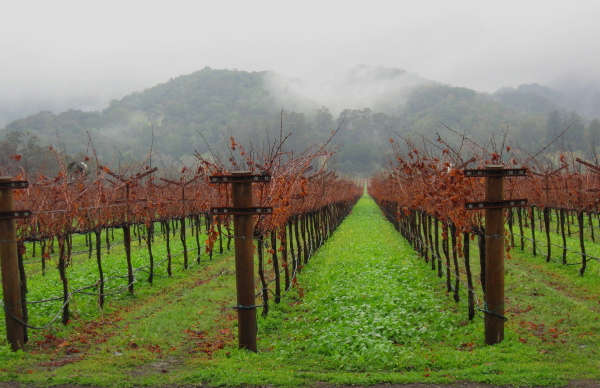
One year ago, as rain relentlessly poured, I stood in a winery and listened to a sage industry veteran talk about obscure grapes and which were his favorites. There was no doubt which was his favorite: Malbec. As he effervesced with passion and his face lit with emotion, he forgot his post in the tasting room, ambled over to a particular bottle and poured himself a glass of dark red wine. It was clear, due to the weather, that no one else would be coming in that day and as this man leaned on the tasting bar with a glass of wine in hand, he started to tell me the tale of his enduring love affair with Malbec. It was the tannins, the fruit, the spice, the structure, yet the notable easy-going nature of the wine that had him hooked. As he continued his tale of how the wine inspired him, his smile broadened, his silver handlebar mustache crept across his face and his eyes twinkled until he ultimately confided in a whisper, “I even barbeque in the rain.”
Anyone who has spent significant time in Northern California in the winter knows that the days of constant heavy rain often seem endless and that sunshine filled blue skies feel like a distant memory. The weather is more than chilly and damp; it is outright cold and soggy. There is no doubt that if a person is committed to barbequing in the rain, that person is passionate. And if a certain wine inspires them in that passionate pursuit, then therein lies something special.
This week as I looked out over the seemingly continual pouring week-long rain in Napa Valley, I could not help but think of this cowboy over the mountain in neighboring Sonoma County. Envisioning the smirk, the twinkle in the eye and the mischievous handlebar mustache, I was certain that a grill was fired up somewhere and that spiced grilled meats and Malbec were sure to follow. And if it could happen there, it could happen here, too.
It may surprise some, but Malbec is a French red wine grape notably grown in Bordeaux. In most French Bordeaux blends, Malbec is combined with Cabernet Franc, Cabernet Sauvignon and/or Merlot. More recently, Malbec has been taking wine publications by storm with featured vintages emerging from Argentina (where it is widely planted). When found made well, the wine is dark in color and robust tannins are present. Being thin-skinned, the Malbec grape needs more sun and heat to grow well. With this in mind, my search for Malbec in Napa Valley lead to the Stag’s Leap District AVA and a visit at Steltzner Vineyards (“Steltzner”).
The Stag’s Leap District in Napa Valley has been recognized as an American Viticultural Area (“AVA”) since 1989, recognized as an ideal AVA for growing Cabernet Sauvignon. It is located just north of the city of Napa and runs south along the Silverado Trail for three miles from Yountville Crossing Road. At Steltzner, the vineyard receives eastern sun exposure and receives the cool evening breezes from the San Pablo Bay. With eastern sun exposure, the Malbec grapes will receive optimum sunlight. Steltzner is committed to making structured wines and its 2006 Estate Malbec is no different. The wine itself consists of 98% of Malbec and 2% of Petit Verdot and is aged for sixteen months in mixed French oak.
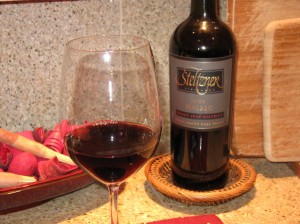
Pouring Steltzner’s 2006 Malbec into the glass, the coloring is dark, rich red hues which as they settle hint at a darker inkier wine. Its bouquet is conducive for being tucked away somewhere warm on a wintery rainy day: capturing one’s attention with aromas of violet, black cherry, warm spices and a hint of leather. Taking a sip, the Steltzner 2006 Malbec caresses the palate smoothly, yet remaining mindful by presenting a distinct structure. While tannins are present, they are not as prevalent as in a Cabernet Sauvignon and the palate experiences nuances of black dried cherry, blackberry, cola and baking spices. With an alcohol level of 14.3%, this is a wine that should be paired with food.
After tasting Steltzner’s 2006 Malbec, my culinary imagination wandered to Argentine cuisine and moreover, Argentine beef. Argentina, most notably recognized for its quality beef, is recognized for its European and predominantly French influences in its cuisine. Given the structure and tannins present in this wine, the innate inclination was to stoke up the charcoal grill for beef. Taking into account the spices, fruit and aromas of this rustic wine, it is evident that something more exotic will pair beautifully and liven up a dreary day. Deciding upon Argentine cuisine, this week’s menu hosts:
1) Sweet Potato-Apricot Tortilla Espanola;
2) Chimichurri Sauce;
3) Charcoal Grilled Matambre Pinwheels; and
4) Marion Blackberry Empanadas Dulces.
Since Argentine cuisine is influenced by the French, it is not surprising that eggs are used in various dishes and the Tortilla Espanola is not an exception. Traditionally a Tortilla Espanola will consist of eggs, potato, sautéed onion and pepper. Other Argentine dishes (such as stews) will use a variety of potatoes and even dried apricots. Seeking to create depth in the dish, I elected to use primarily traditional sweet potatoes (not yams), one white potato, rehydrated dried apricots, sautéed sweet yellow onion, pepper and eggs. Once baked in the oven, the consistency was perfect with just a hint of egg flavor yet the eggs helped hold the other ingredients together to create a rustic thick tortilla. This dish can either serve as tapas (as a precursor to the main dish) or can be served alongside. When consumed alongside the wine, the wine’s spices become more pronounced as if to naturally tango with the pepper in the Tortilla Espanola. The apricot provides a tangy zip to the dish and gives it more flavorful depth.

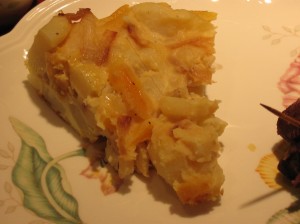
No Argentine meal is complete without the classic Chimichurri Sauce, whether it is used for the upcoming beef dish or drizzled with the Tortilla Espanola.
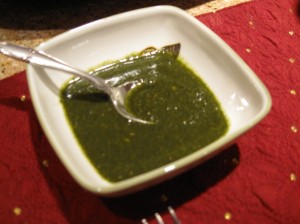
Matambre in Argentina is a beef dish which is traditionally roasted in the oven and then served chilled (in order to slice properly). The dish itself involves flattening beef with a meat mallet such that cooked chopped spinach, carrots, onions and chopped hardboiled eggs can be layered on top. Next the meat is rolled and tied with cooking string and roasted. Seeking a creative twist on Matambre, I elected to use my charcoal grill instead. In preparation, I first marinated my lean thinly sliced steak in a combination of Malbec wine, fresh thyme and garlic gloves for six (6) hours. Once marinated, I seasoned the meat with some sea salt and spices, and proceeded to layer chopped cooked spinach, cooked julienned carrots, thinly sliced sautéed sweet onion, and finely chopped hardboiled egg. Carefully rolling the beef, I fastened it with toothpicks and inserted skewers appropriate for the grill. Next I sliced the rolled beef into pinwheels and moved the extra pieces to the end of each skewer.
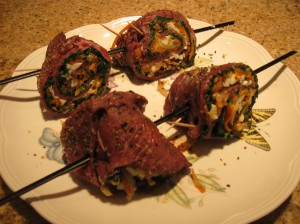
Once assembled, the skewers were placed on a hot charcoal grill, cut side down and the lid for the grill was lowered to help infuse more smoke flavor. After being grilled on each cut side a few minutes, the pinwheels emerged, still intact and ready for consumption.
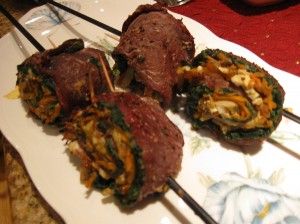
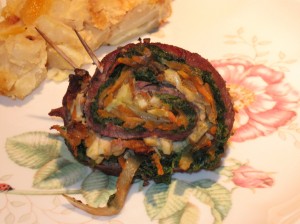
After personally feeling like a culinary magician, the Matambre Pinwheels proved a savory grilled delight. Rolling the marinated beef helped maintain tenderness and juice. The hardboiled egg again helped hold the contents together but also added a slight creamy consistency and flavor to the dish as a whole. The layers of various flavors actually provided structure to the dish which made its pairing with the wine even better. The carrot picked up the flavor of thyme from the marinated beef. Slicing into a Matambre Pinwheels proved heavenly as the flavors melded together to create the proverbial “perfect bite”. Taken together, the meat is smoky and spiced and the wine is rich and lush.
To finish, a sweet version of Empanadas was created. Typically Empanadas can be filled with beef, cheese or vegetables. However, they can also be created as a dessert provided that the filling is sweet. Thinking about the fruit flavors in the wine, Marion Blackberry conserves would create a perfect filling for properly paired sweet empanada. Once the Marion Blackberry Empanadas Dulces emerged from the oven, they were quickly tossed in a mixture of sugar and cinnamon. The cinnamon was chosen to accentuate the spices found in the wine.
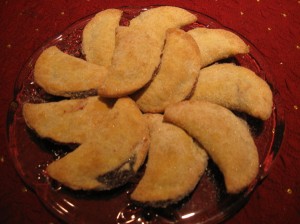
Finishing the meal it was easy to understand why that “wine cowboy” in Sonoma spoke so passionately about barbequing and Malbec. The smoky grill, structured tannic Malbec, varied flavors and spices soulfully complement one another. Taken together, the exotic meal and the rustic wine enlivened the senses on an otherwise soggy, cold day. As winter continues, release your inner-gaucho, follow your innate sense of adventure and explore Malbec.
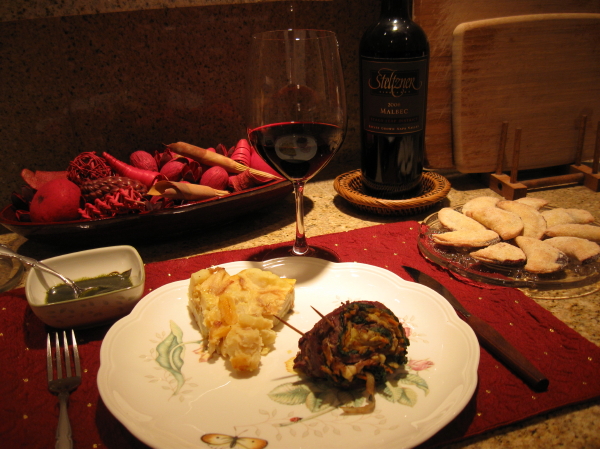
Comments Off on Cowboys and Malbec